March 26, 2021 feature
A bio-inspired mechano-photonic artificial synapse
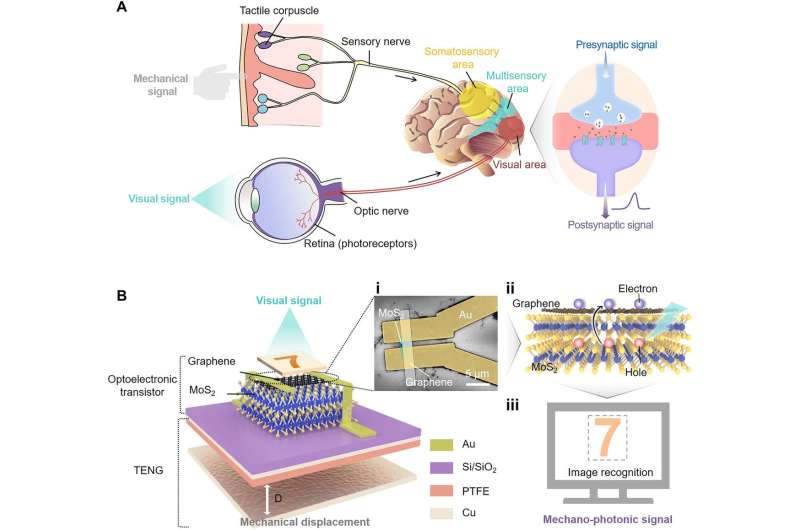
Multifunctional and diverse artificial neural systems can incorporate multimodal plasticity, memory and supervised learning functions to assist neuromorphic computation. In a new report, Jinran Yu and a research team in nanoenergy, nanoscience and materials science in China and the US., presented a bioinspired mechano-photonic artificial synapse with synergistic mechanical and optical plasticity. The team used an optoelectronic transistor made of graphene/molybdenum disulphide (MoS2) heterostructure and an integrated triboelectric nanogenerator to compose the artificial synapse. They controlled the charge transfer/exchange in the heterostructure with triboelectric potential and modulated the optoelectronic synapse behaviors readily, including postsynaptic photocurrents, photosensitivity and photoconductivity. The mechano-photonic artificial synapse is a promising implementation to mimic the complex biological nervous system and promote the development of interactive artificial intelligence. The work is now published on Science Advances.
Brain-inspired neural networks.
The human brain can integrate cognition, learning and memory tasks via auditory, visual, olfactory and somatosensory interactions. This process is difficult to be mimicked using conventional von Neumann architectures that require additional sophisticated functions. Brain-inspired neural networks are made of various synaptic devices to transmit information and process using the synaptic weight. Emerging photonic synapse combine the optical and electric neuromorphic modulation and computation to offer a favorable option with high bandwidth, fast speed and low cross-talk to significantly reduce power consumption. Biomechanical motions including touch, eye blinking and arm waving are other ubiquitous triggers or interactive signals to operate electronics during artificial synapse plasticization. In this work, Yu et al. presented a mechano-photonic artificial synapse with synergistic mechanical and optical plasticity. The device contained an optoelectronic transistor and an integrated triboelectric nanogenerator (TENG) in contact-separation mode. The mechano-optical artificial synapses have huge functional potential as interactive optoelectronic interfaces, synthetic retinas and intelligent robots.
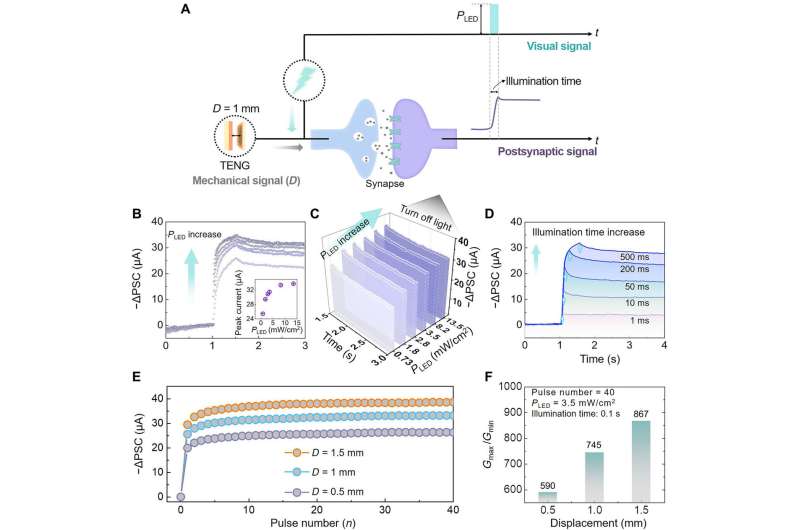
The mechano-photonic artificial synapse
The human brain and its associated biomechanical and visual sensations are critical to acquire somatosensory and visual information. The brain contains a variety of neurons that receive interactive signals through varied modes to implement neuromorphic computation in the multisensory association area. Synapses from important points of connection between two adjacent neurons during neural information transmissions. Yu et al. were bioinspired by the brain and nervous system to develop a mechano-photonic artificial synapse with synergistic mechanical and optical plasticity. The mechano-photonic artificial synapse included an optoelectronic transistor and integrated TENG (triboelectric nanogenerator). During the experiments, the team used chemical vapor deposition to deposit monolayer graphene on the optoelectronic transistor, which they then stacked on a multilayer molybdenum sulfide (MoS2) flake on a silicon dioxide substrate. Using the experimental setup, Yu et al. could realize the synergistic optical and mechanical modulation on the synaptic plasticity.
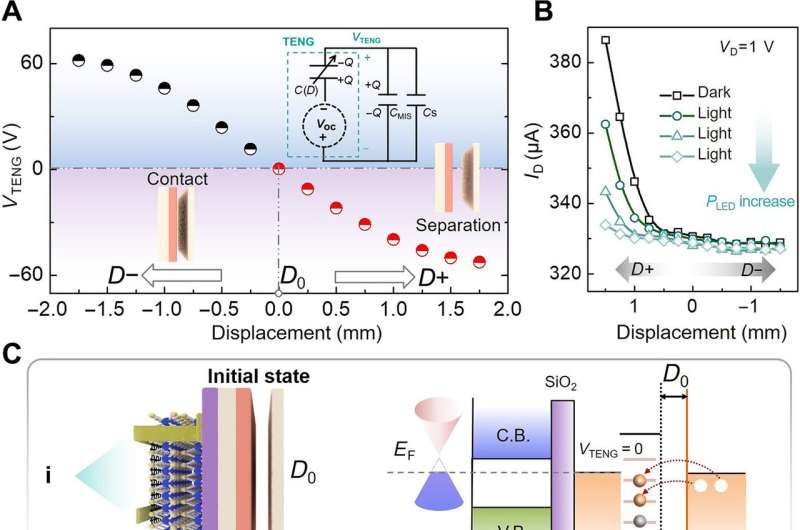
Testing the device and mechano-optical characterization.
To test the practicality of triboelectric potential gating, the team characterized the TENG output voltage versus mechanical displacement using a test circuit, where they connected the transistor dielectric capacitor and test system capacitor with TENG in parallel. By optimizing the MoS2 thickness in the heterostructure, Yu et al. improved the device photosensitivity and electrical performance to potentially influence the device for system-level applications. To characterize the mechano-optoelectronic transistor, they measured the output performance under synergistic effects for TENG displacement and illumination with green LED at different power intensities. To then understand the tunable photoresponsivity of the mechano-photonic transistor of the device, they studied the influence of mechanical displacement on the photocurrent and photosensitivity. A more positive displacement can induce larger photocurrent and higher photo-receptivity relative to the electric field-dependent Fermi-level and electronic states in the heterostructure. The mechanical displacement related photoresponse improved the photosensitivity of the device while regulating the feature at a desired level on demand.
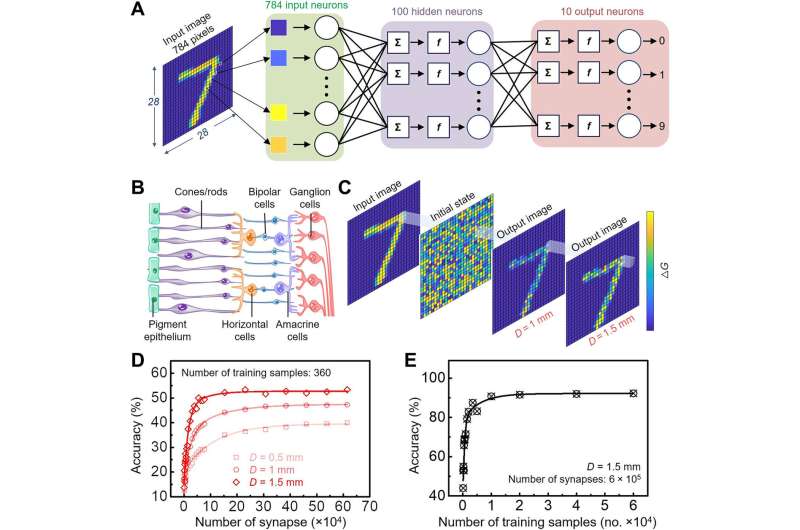
Channel conductivity and long-term synaptic plasticity.
The team then regulated the channel conductivity of the transistor using mechanical displacement and light illumination; fundamental for multimodal plasticity in mechano-photonic artificial synapses. They maintained the basal post-synaptic current (PSC) stable at different levels under different displacement states as a pre-requisite to accomplish synaptic photoresponses. The work showed the effects of the triboelectric potential-modulated electrical behaviors and optoelectrical behaviors on the post-synaptic current. They retained the mechano-photonic artificial synapse for more than an hour without changes to provide evidence to implement the synergistic optical and mechanical module for long-term synaptic plasticity. The team credited the decreased postsynaptic current (PSC) to the weakened density of holes in graphene used within the setup, on the other hand they credited the persistent PSCs to localized states in MoS2 and the directional triboelectric field. For instance, during light illumination, photogenerated electrons could be induced in the MoS2. When compared to previous work of bioinspired synaptic devices, the present mechano-photonic artificial synapse simultaneously realized dual-mode plasticization via mechanical and visual signals.
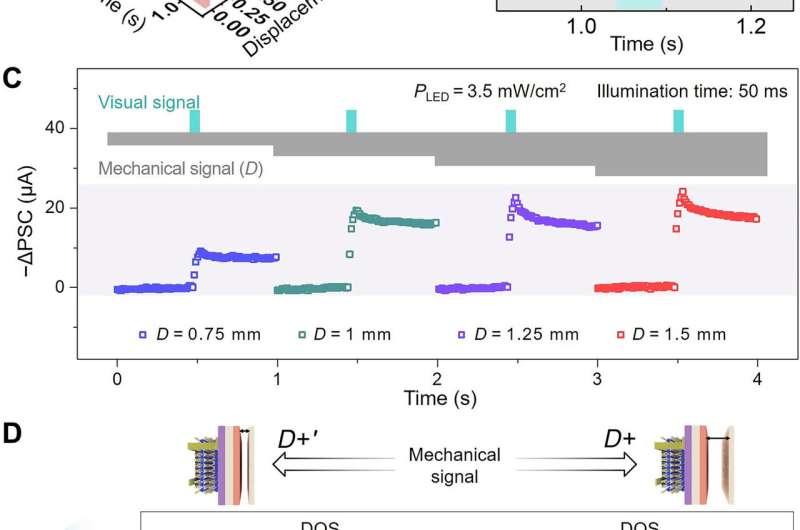
Simulating an artificial neural network (ANN) for image recognition.
Yu et al. further examined the synergistic effects of the artificial synapse under light pulse inputs embodying diverse spatio-temporal information. They then simulated a multilayer perception-based artificial neural network (ANN) using typical synaptic characteristics for supervised learning function using the modified National Institute of Standards and Technology (MNIST) handwriting image dataset. In the ANN, Yu et al. included 28 x 28 input neurons, 100 hidden neurons, and 10 output neurons fully connected via synaptic weights. The total of 784 input neurons corresponded to a 28 x 28 MNIST image and the 10 output neurons corresponded to 10 Arabic numbers from zero to nine. The team built the ANN bioinspired by the human retina, which contrastingly contains billions of nerve cells to form a complex three-layered network. They then showed how improving the periodicity, stability and repeatability of the device improved the simulation of ANN for image recognition.
Outlook
In this way, Jinran Yu and colleagues developed a mechano-photonic artificial synapse with synergistic multimodal synaptic plasticity. The team used triboelectric potential to drive he synaptic transistor and regulate the charge transfer exchange in the heterostructure to facilitate post-synaptic photocurrents, persistent photoconductivity and photosensitivity. The setup also allowed long-term memory and consecutive neural facilitation. The team then simulated an artificial neural network (ANN) to show the feasibility of mechanical plasticization to promote image recognition accuracy. The work will pave the way to develop multifunctional and interactive neuromorphic devices.
More information: 1. Yu J. et al. Bioinspired mechano-photonic artificial synapse based on graphene/MoS2 heterostructure, Science Advances, 10.1126/sciadv.abd9117
2. Adam G. C. et al. Two artificial synapses are better than one. Nature, doi.org/10.1038/d41586-018-05297-5
3. Choi S. et al. SiGe epitaxial memory for neuromorphic computing with reproducible high performance based on engineered dislocations, Nature Materials, doi.org/10.1038/s41563-017-0001-5
Journal information: Science Advances , Nature , Nature Materials
© 2021 Science X Network




















